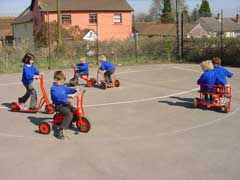
Vol. III, No. 5, May 2004
Supervision of Outdoor Environments
 One
thing that we do not understand in early childhood is why a teacher is both
allowed and encouraged to sit inside the classroom, yet when you take the
same children outside, somehow they no longer afforded the opportunity to
sit with a child or snuggle up with a toddler in a comfortable space. While
we do not advocate large benches or picnic tables where teachers can congregate
and possibly overlook their supervision duties, we feel that you can provide
the right type of seating outdoors that will both provide comfort for the
teacher and allow the right type of supervision. If we can figure it out indoors,
we can also figure it out outdoors.
One
thing that we do not understand in early childhood is why a teacher is both
allowed and encouraged to sit inside the classroom, yet when you take the
same children outside, somehow they no longer afforded the opportunity to
sit with a child or snuggle up with a toddler in a comfortable space. While
we do not advocate large benches or picnic tables where teachers can congregate
and possibly overlook their supervision duties, we feel that you can provide
the right type of seating outdoors that will both provide comfort for the
teacher and allow the right type of supervision. If we can figure it out indoors,
we can also figure it out outdoors.
One suggestion is to place small benches with backs or individual seats in areas where large groups of children will be playing, such as near the sand box area, block play area or near the climbing structure. Logs that are cut in chunks about 20" high are comfortable for teachers, yet not dangerous for children to climb upon. Small rockers and wooden gliders available from garden supply places are perfect for infant yards.
As in the classroom, supervision outdoors is important since many accidents can happen in the outdoor space. Most childcare regulations are vague was to what is required outdoors, so here are a few ways to improve your outdoor supervision.
- Maintain the proper adult to child ratios. Whether your licensing regulations require it or not, keep the same adult to child ratio outdoors that you follow indoors. Depending on the outdoor activity, you might in fact need additional supervision.
- Have a supervision plan. Teachers need to know where they should be watching and what types of problems they might encounter outdoors. Map out your play yard and decide who will supervise what activities. Make staff aware of what area they will be responsible for.
- Use the buddy system. It is best for a teacher and the children if groups with one teacher not go out alone, but rather combine with other groups to provide additional supervision. The outdoor area is usually too large for one teacher to supervise alone. One teacher at least on the yard should have training in pediatric first-aid/CPR.
- Have an emergency plan. You will need a plan of action for both accidents and more serious emergencies. Who will be contacting 911? Who will administer first aid? Who will call the parents? These are just a few of the items that need to be outlined.
- Rehearse the plan. Most state licensing regulations require that you practice indoor safety procedures such as fire drills and tornado drills but state nothing about practicing outdoor safety drills. Children panic in an emergency situation; therefore practice will enable both staff and children to be better prepared to address the situation at hand. Set up a regular time when you will practice your outdoor emergency plan and record your times of practice for your insurance company.
- Communication issues. How will the outdoor staff be able to communicate with the indoor staff, not only in an emergency, but also in the daily operations of the program such as during pick-up time? If possible, staff should have access to mobile phones or walkie-talkies.
- On-going outdoor play yard inspections. Just as you inspect the classroom for hazards on a daily basis, a checklist for daily and weekly inspections will help to keep your outdoor area maintained well and help cut down the incidents of injury.
- On-going training. At least one person on your staff will need to be a certified playground safety inspector. This training is provided by both the National Program for Playground Safety and the National Park and Recreation Association. The person who is certified can be the person responsible for developing on-going training for staff in safety and supervision issues, as well as the person who completes regular inspections. This requirement was added to the proposed NAEYC Accreditation Standards for a child care program being accredited after 2005.
Outdoor supervision requires the same planning, forethought and follow-up
that are needed to supervise the indoor classroom. A safer outdoor environment
can help give your children the freedom they need to explore the outdoor world
and all its wonders.

